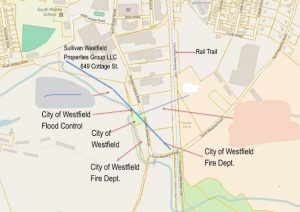WESTFIELD—The city’s Little River Levee was inspected earlier this month by the US Army Corps of Engineers and was found to be unacceptable, according to Westfield Flood Control Commission Chairman Al Giguere.
According to Giguere, the levee was inspected on Nov. 1 and was found to be unacceptable, with several deficiencies about the structure. Giguere said that this is a finding that occurred last year for the Little River Levee as well, and that work is being done to try and alleviate the issues. However, the work could be costly and slow-moving, and Giguere said that the entire levee may need to be reconstructed.
“It is unacceptable, which means that the levee is for all intents and purposes not certifiable by the Army Corps of Engineers,” Giguere said.
“Essentially, the Army Corps of Engineers will not certify that the levee will function to its designed specifications,” he added.
Giguere said that in spite of the condition of the levee, there is no immediate danger to anyone unless a large storm provides more than 10 inches of rain in the area, or the Cobble Mountain Reservoir has an emergency.
The levee is located off of Ponders Hollow Road, and protects the southern flank of downtown Westfield from Little River, according to Giguere. He said that it is about 2,500 feet long and that the Westfield Flood Commission currently has authority over and maintains a 500-foot section of the levee, while the rest is under the purview of other city departments. It was constructed in 1955 by the Army Corps of Engineers, within days of that year’s flood, Giguere said.
The report given by Giguere was unofficial, with an official one expected before Jan. 1, 2018, though it highlighted key issues with the levee.
The biggest issue, according to Giguere, is that two drainage pipes that drain a catch basin off Ponders Hollow Road and into the Westfield River are corroded, which means there would be no way of stopping the Little River from backflowing into the city during a major flooding event.
In addition, there is an overgrowth of trees and brush on the higher portion of the structure in its unmaintained areas. Also, there is deterioration and overall poor conditions of the unmaintained portion, which has become heavily eroded.
In order to address the issues, Giguere said that the Flood Control Commission has worked to remediate issues they are in control of.
“They’re understanding that we are trying to make changes and fix what’s wrong with it but it’s a slow process,” Giguere said of the Army Corps of Engineers.
However, he said that the levee may need to be completely replaced and the cost of that is uncertain. He also noted that the city is in the first phase of getting the levee repaired by having it surveyed.
According to Giguere, the levee has gone through the inspection process with the US Army Corps of Engineers coming out regularly over the past 10 years, which is about every other year.
However, due to issues such as Hurricanes Katrina and Sandy, increased attention and inspections have come to the levee, happening annually over the past four to five years, Giguere said.


